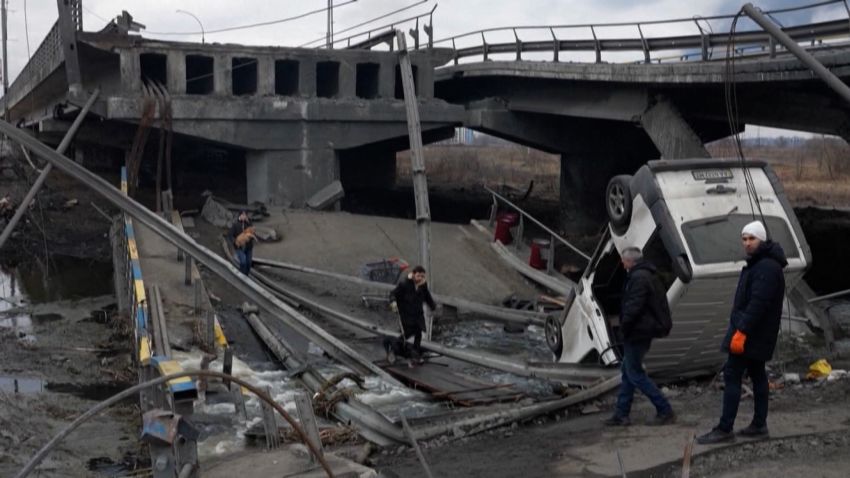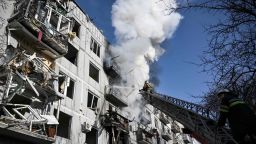Russia’s unprovoked invasion of Ukraine has prompted a roiling debate about what US involvement should look like.
US officials have made clear that American troops won’t engage directly with Russian forces, and NATO members have pushed back on calls for a no-fly zone to be set up in Ukraine, warning that it could lead to a “full-fledged war in Europe.”
The situation could change quickly, however, if Moscow’s attack on Ukraine spilled into a NATO member nation and triggered a response based on the alliance’s Article 5 principle.
But what is Article 5, and how does it apply to the ongoing war in Ukraine?
Here’s what you need to know:
What is Article 5?
Article 5 is the principle that an attack on one member of NATO is an attack on all members. It’s been a cornerstone of the 30-member alliance since it was founded in 1949 as a counterweight to the Soviet Union.
The principle aims to deter potential adversaries from attacking NATO members. Article 5 guarantees that the resources of the whole alliance can be used to protect any single member nation. This is crucial for many of the smaller countries who would be defenseless without their allies. Iceland, for example, has no standing army.
Since the US is the largest and most powerful NATO member, any state in the alliance is effectively under US protection.
According to the NATO website, Article 5 specifically lays out:
“The Parties agree that an armed attack against one or more of them in Europe or North America shall be considered an attack against them all and consequently they agree that, if such an armed attack occurs, each of them, in exercise of the right of individual or collective self-defense recognized by Article 51 of the Charter of the United Nations, will assist the Party or Parties so attacked by taking forthwith, individually and in concert with the other Parties, such action as it deems necessary, including the use of armed force, to restore and maintain the security of the North Atlantic area.
Any such armed attack and all measures taken as a result thereof shall immediately be reported to the Security Council. Such measures shall be terminated when the Security Council has taken the measures necessary to restore and maintain international peace and security.”
During the Cold War, the main concern was the Soviet Union, but in recent years, Russia’s aggressive actions in eastern Europe have been the focus of attention.
Has Article 5 ever been invoked?
Article 5 has only been invoked once: After the September 11, 2001, terror attacks on the US.
But NATO’s Article 5 principle stretches beyond attacks on the homeland. The alliance has also taken collective defense measures on several occasions, including deploying Patriot missiles in 2012 on the Syrian-Turkish border and bolstering its forces in Estonia, Latvia, Lithuania and Poland following Russia’s annexation of Crimea in 2014.
NATO allies have also joined the US to fight in Afghanistan, Iraq and Syria.
How does Article 5 apply to Russia’s attack on Ukraine?
Since Ukraine is not a member of NATO, the US is not compelled to protect the country the same way it would if a NATO member nation was attacked.
But many of Ukraine’s neighbors are NATO members, and if a Russian attack extended into one of those countries, Article 5 could trigger direct involvement from the US and other NATO members.
What constitutes an attack on a NATO member nation?
The Article 5 language specifies that an “armed attack” on a member nation is what triggers collective action.
But what constitutes an “armed attack” is up to NATO members, and Russia’s aggressive posture has already prompted concern about the country’s willingness to potentially tempt a NATO response.
For example, Democratic Sen. Mark Warner of Virginia told The Washington Post recently that a Russian cyberattack on Ukraine could lead to consequences beyond the intended “geographic boundaries” and affect NATO members.
“It could end up bleeding into Poland or Romania or into the Baltic states and cause damage that would shut down hospitals, and potentially, you’ve got American troops there. If American troops in a truck crash because the lights were out, you could get very close to Article 5,” Warner, the Senate Intelligence Committee chairman, told the outlet.
Russia’s attack on the Zaporizhzhia nuclear power plant site – the largest in Europe – had prompted similar concern. While local authorities said there’s been “no change in radiation levels” in the area, what if there had been a radiation leak that spread into a NATO member nation?
“That’s a question for the alliance to make,” Pentagon spokesman John Kirby told CNN earlier this month. “Specifically, I would just remind that Article 5 makes it clear that it’s an armed attack on a NATO ally triggers Article 5. … But how that’s interpreted – that would be really something for the NATO alliance to determine.”
What are US officials currently saying about Article 5?
US Secretary of State Antony Blinken has reiterated the US’ and allies’ commitment to NATO’s Article 5, stating, “If there is any aggression anywhere, on NATO territory on NATO countries, we the United States, all of our allies and partners will take action to defend every inch of NATO territory. It’s as clear and direct as that.”
The comments from the top US diplomat echoed President Joe Biden’s pledge during his State of the Union address to “defend every inch of territory of NATO countries with the full force of our collective power.”
CNN’s Jeremy Herb contributed to this report.






